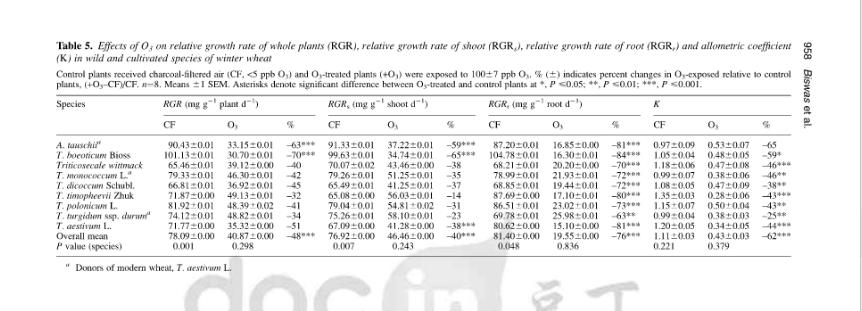博文
现代小麦高臭氧敏感性与野生及栽培亲本的遗传相关性研究
|||
现代小麦高臭氧敏感性与野生及栽培亲本的遗传相关性研究
比斯沃斯,许宏,李永庚,刘美珍.,陈艳红,孙家柱,蒋高明*
*通讯作者
中国科学院植物研究所植被与环境变化国家重点实验室, 北京香山南辛村20号,100093。
实验植物学报,2008,59:951-963. (IF=5.345, SCI 引用79)
现代小麦(Triticum aestivum L.)是对臭氧(O3)最敏感的作物之一,但人们对其O3敏感性的遗传背景知之甚少。探讨不同品种小麦对O3浓度升高的响应,是选育O3抗性品种的基础工作。将冬小麦野生种和栽培种(包括A、B和D基因组的供体)暴露于100ppb O3或活性炭过滤空气中21d,通过可见O3伤害症状、气体交换、叶绿素荧光、相对生长速率和生物量积累来评估不同年度小麦对O3升高的响应。臭氧显著降低了净光合速率(-37%)和瞬时蒸腾速率(-42%),但增加了气孔导度(+11%)和胞间CO2浓度(+11%)。高O3降低了基础荧光(-8%)、最大荧光(-26%)、可变荧光(-31%)和最大光化学效率(-7%)。臭氧降低了相对生长速率和异速生长系数,最终降低了总生物量累积(-54%),但根(-77%)比茎(-44%)降低程度更大。冬小麦在高O3对光合作用和生长的影响上表现出明显的种间变异。原始栽培小麦对O3的相对耐受性最高,现代小麦次之,野生小麦最低。在现代小麦基因组供体中,节节麦(DD)对O3最敏感,其次是单粒小麦(AA)和硬粒小麦(Triticum turgidum ssp)。硬粒小麦(AABB)似乎是最耐O3的。结果表明,现代小麦对O3的敏感性较高是由于节节麦(DD)对O3的敏感性增加所致,而不是来自硬粒小麦(Triticum turgidum ssp)形成过程中的硬粒基因(AABB)。
Assessing the genetic relatedness of higher ozone sensitivity of modern wheat to its wild and cultivated progenitors/relatives
Biswas D.K., Xu H, Li Y.G., Liu M.Z., Chen Y.H., Sun J.Z. & Jiang G.M*
*correspondence author
State Key Laboratory of Vegetation and Environmental Change, Institute of Botany, The Chinese Academy of Sciences, 20 Nanxincun, 100093 Beijing, PR China
Journal of Experimental Botany, 2008, 59: 951-963.(IF=5.345, SCI citation 79)
Abstract Modern wheat (Triticum aestivum L.) is one of the most ozone (O3)-sensitive crops. However, little is known about its genetic background of O3 sensitivity, which is fundamental for breeding O3-resistant cultivars. Wild and cultivated species of winter wheat including donors of the A, B and D genomes of T. aestivum were exposed to 100 ppb O3 or charcoal-filtered air in open top chambers for 21 d. Responses to O3 were assessed by visible O3 injury, gas exchange, chlorophyll fluorescence, relative growth rate, and biomass accumulation. Ozone significantly decreased light-saturated net photosynthetic rate (-37%) and instantaneous transpiration efficiency (-42%), but increased stomatal conductance (+11%) and intercellular CO2 concentration (+11%). Elevated O3 depressed ground fluorescence (-8%), maximum fluorescence (-26%), variable fluorescence (-31%), and maximum photochemical efficiency (-7%). Ozone also decreased relative growth rate and the allometric coefficient, which finally reduced total biomass accumulation (-54%), but to a greater extent in roots (-77%) than in the shoot (-44%). Winter wheat exhibited significant interspecies variation in the impacts of elevated O3 on photosynthesis and growth. Primitive cultivated wheat demonstrated the highest relative O3 tolerance followed by modern wheat and wild wheat showed the lowest. Among the genome donors of modern wheat, Aegilops tauschii (DD) behaved as the most O3-sensitive followed by T. monococcum (AA) and Triticum turgidum ssp. durum (AABB) appeared to be the most O3-tolerant. It was concluded that the higher O3 sensitivity of modern wheat was attributed to the increased O3 sensitivity of Aegilops tauschii (DD), but not to Triticum turgidum ssp. durum (AABB) during speciation.




https://blog.sciencenet.cn/blog-475-1207485.html
上一篇:有机肥对中国温带农田土壤微生物群落多样性及土壤微环境的影响
下一篇:人工湿地处理富营养化水体潜力研究:来自太湖的证据